
How to Make Old-Fashioned Strawberry Jam
Pdf print version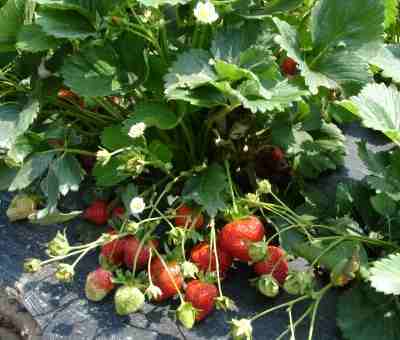 Making and canning your own
old-fashioned strawberry jam without pectin is also easy.
Just scroll down this page to see how to do it, in easy steps and completely illustrated.
But let me be clear: I prefer to use pectin (it's natural, made from apples) because it uses less
sugar, ensures a good set, and takes much, much less time to cook... BUT...
people have asked for the old pre-pectin recipe, so here it is. These directions work equally well for strawberry, raspberry, blackberry, blueberry, boysenberry, dewberry, gooseberry, loganberry, marionberry, peach, plum, damson plum, tayberry, youngberry, etc.; by themselves or mixed berry jam. I've got some other pages for specific types of jam
and butters, too, see this page
Making and canning your own
old-fashioned strawberry jam without pectin is also easy.
Just scroll down this page to see how to do it, in easy steps and completely illustrated.
But let me be clear: I prefer to use pectin (it's natural, made from apples) because it uses less
sugar, ensures a good set, and takes much, much less time to cook... BUT...
people have asked for the old pre-pectin recipe, so here it is. These directions work equally well for strawberry, raspberry, blackberry, blueberry, boysenberry, dewberry, gooseberry, loganberry, marionberry, peach, plum, damson plum, tayberry, youngberry, etc.; by themselves or mixed berry jam. I've got some other pages for specific types of jam
and butters, too, see this page- For more information about strawberries, see Strawberry Picking Tips and Miscellaneous strawberry facts.
Ingredients
- Strawberries - preferably fresh, but frozen (without syrup) works, too. A batch requires 6 cups of crushed berries, so you will need about 8 to 10 cups of raw whole strawberries.
- Sugar - About 6 cups of dry, granulated (table) sugar. Can you use honey instead? Yes, the same amount of honey can be used in place of sugar, but it probably won't give you a good set. It still takes great, though. And for the no-sugar recipe, click here
Yield
About eight 8-ounce jars
Equipment
- Jar funnel ($5 at Target, other big box stores, and often grocery stores; and available online - see this page) or order it as part of the kit with the Jar grabber .
- At least 1 large pot; I prefer 16 to 20 quart Nonstick ceramic coated pots for easy cleanup.
- Large spoons and ladles,
- 1 Water Bath Canner (a huge pot to sanitize the jars after filling (about $30 to $35 at mall kitchen stores, sometimes at big box stores and grocery stores.). Note: we sell canners and supplies here, too - at excellent prices - and it helps support this web site!
- Half pint canning jars (Grocery stores, like Publix, Kroger, Safeway carry them, as do some big box stores - about $7 per dozen 8 ounce jars including the lids and rings)
- Lids - thin, flat, round metal lids with a gum binder that seals them against the top of the jar. They may only be used once.
- Rings - metal bands that secure the lids to the jars. They may be reused many times.
Optional stuff:
- Foley Food Mill - not necessary; useful if you want to remove seeds (from blackberries) or make applesauce.
- Lid lifter (has a magnet to pick the lids out of the almost-boiling water where you sanitize them. ($4 at big box stores or it comes in the kit at left)
- Jar grabber (to pick up the hot jars)- Big box stores and grocery stores sometimes carry them; and it is available online - see this page. It's a tremendously useful to put jars in the canner and take the hot jars out (without scalding yourself!). The kit sold below has everything you need, and at a pretty good price:
Strawberry Jam-making Directions
This example shows you how to make either Strawberry jam or Strawberry - Raspberry - Blackberry Jam - also called Triple Berry Jam (my favorite, and everyone I give a jar to, says it has become their favorite, too!) But you can use this recipe to make any type of jam; where there is a difference, I will point it out! The yield from this recipe is about 8 eight-ounce jars (which is the same as 4 pints).
Step 1 - Pick the berries! (or buy them already picked)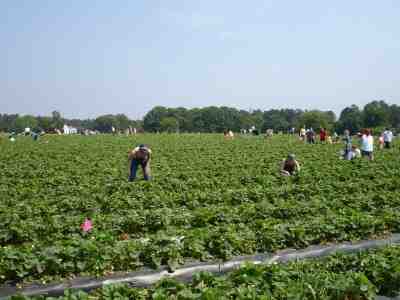
It's fun to go pick your own and you can obviously get better quality ones! See this page for strawberry facts and picking tips
At right is a picture of a typical strawberry field.
I prefer to grow my own; which is really easy - but that does take some space and time and can be challenging.
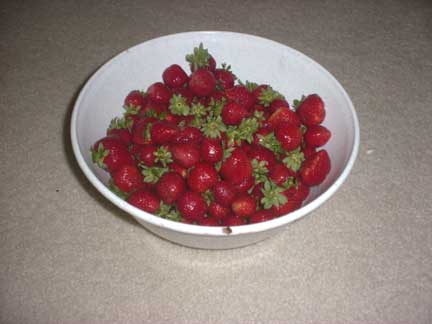 As mentioned in the
ingredients section; you may use frozen berries (those without syrup or added sugar); which is especially useful if you want to make some
strawberry jam in December to give away at Christmas!
As mentioned in the
ingredients section; you may use frozen berries (those without syrup or added sugar); which is especially useful if you want to make some
strawberry jam in December to give away at Christmas!
Above and at left are strawberries and blackberries that I picked at a pick-your-own farm. If you want to pick your own, here is a list and links to the pick your own farms.
How much fruit?
Strawberry Jam can ONLY be made in rather small batches - about 6 cups at a time - like the directions on the pectin say, DO NOT increase the recipes or the jam won't "set" (jell, thicken). (WHY? Alton Brown on the Food Channel says pectin can overcook easily and lose its thickening properties. It is easier and faster to get an even heat distribution in smaller batches. It takes about 8 to 10 cups of raw, whole strawberries to yield 6 cups of hulled, crushed berries per batch. For triple berry jam, I use 4 cups of mushed (slightly crushed) strawberries, 2 cups of raspberries and 2 cups of blackberries. For strawberry-only jam; you will need 6 cups of mushed strawberries.
Step 2 - Wash the jars and lids
 Now's a good time to get the jars ready, so you won't be rushed later. The dishwasher is fine for the jars; especially if it has a "sanitize" cycle, the water bath processing will sanitize them as well as the contents! If you don't have a dishwasher with a sanitize cycle, you can wash the containers in hot, soapy water and rinse, then sanitize the jars by boiling them 10 minutes, and keep the jars in hot water until they are used.
Now's a good time to get the jars ready, so you won't be rushed later. The dishwasher is fine for the jars; especially if it has a "sanitize" cycle, the water bath processing will sanitize them as well as the contents! If you don't have a dishwasher with a sanitize cycle, you can wash the containers in hot, soapy water and rinse, then sanitize the jars by boiling them 10 minutes, and keep the jars in hot water until they are used.
NOTE: If a canning recipe calls for 10 minutes or more of process time in the canner, then the jars do not need to be "sanitized" before filling them. But really, sanitizing them first is just good hygeine and common sense! See this page for more detail about cleaning and sanitizing jars and lids.
Put the lids into a pan of hot, but not quite boiling water (that's what the manufacturer's recommend) for 10 minutes, and use the magnetic "lid lifter wand" to pull them out. Leave the jars in the dishwasher on "heated dry" until you are ready to use them. Keeping them hot will prevent the jars from breaking when you fill them with the hot jam.
Step 3 -Wash and hull the fruit!
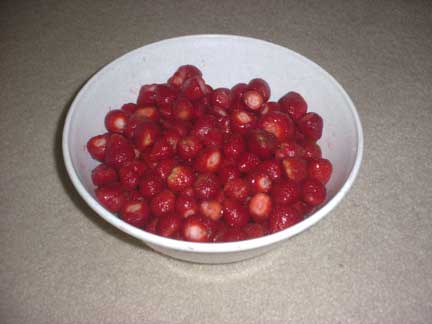 I'm sure you can figure out how to wash the fruit in plain cold water.
I'm sure you can figure out how to wash the fruit in plain cold water.
With strawberries you must remove the hulls. With other berries, just pick off any stems and leaves.
Step 4 - Crush the fruit
Then you just mush them up a bit - not completely
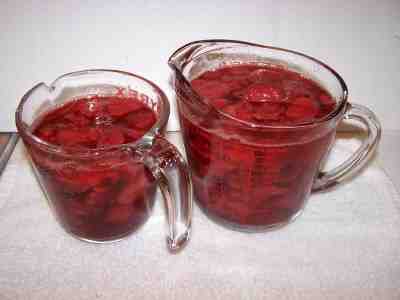 crushed, but mostly. Most people seem to like large chunks of fruit but crushing them releases the natural pectin so it can thicken. You will need about 6 cups, mushed up.
crushed, but mostly. Most people seem to like large chunks of fruit but crushing them releases the natural pectin so it can thicken. You will need about 6 cups, mushed up.
If you want seedless jam, you may need to run the crushed berries through a food mill (below).
The Villaware has a selection of screens, including a fine screen that works on
strawberries. The Foley stops blackberries seeds, but most raspberry and
all strawberry seeds pass through. They cost between $25 to $60. 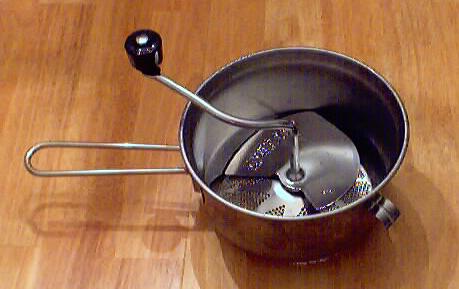
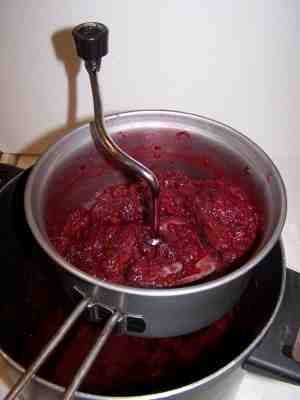
Step 5 - Measure out the sugar, honey or other sweetener.
You will need 6 cups of sugar (or about the same of honey).
You can make a strawberry jam with no added sugar if you use the "No-added sugar pectin" but honestly, the resultant jam just isn't as good. It tends to be darker, more runny and less flavorful. If you would rather try to make jam with no added sugar, click here for those directions! But using the no-added sugar pectin with a reduced amount of sugar, about 4 cups instead of the usual 6 cups, works GREAT! See this page for the recipe for jam using pectin.
Step 6 - Get the lids warming in hot (but not boiling) water
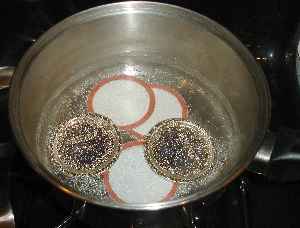 Lids: put the lids into a pan of hot water for at least several minutes; to soften up the gummed surface and clean the lids.
Lids: put the lids into a pan of hot water for at least several minutes; to soften up the gummed surface and clean the lids.
Need lids, rings and replacement jars?
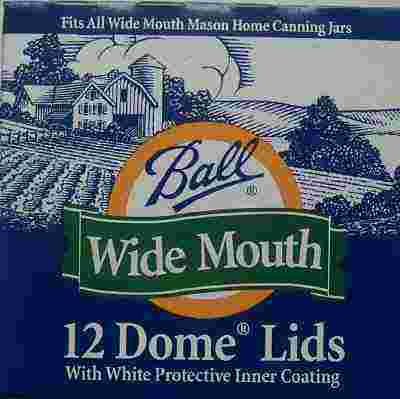

 Get them all here, delivered direct to your home, at the best prices on the internet!
Get them all here, delivered direct to your home, at the best prices on the internet!
Step 7 - Mix the berries and sugar; bring slowly to a full boil
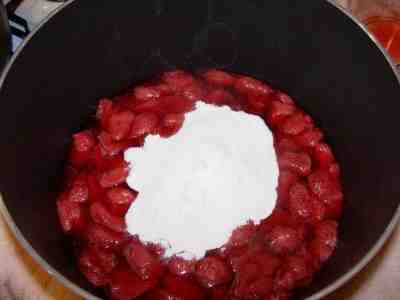 Combine
the berries and sugar (or honey). Bring slowly to a boil, stirring occasionally
until sugar dissolves.
Combine
the berries and sugar (or honey). Bring slowly to a boil, stirring occasionally
until sugar dissolves.
Why use pectin? I'll put in a plug for pectin here: You may run into grandmotherly types who sniff "I never used pectin!" at you. Well, sure, and their generation took a horse and buggy to work, died of smallpox and ate canned meat and green beans that tastes like wet newspapers. Old fashioned ways are not always better nor healthier. Pectin, which occurs naturally in fruit, is what makes the jam "set" or thicken (together with sugars and acids in the fruit). The pectin you buy is just natural apple pectin, more concentrated. Using pectin dramatically reduces the cooking time, which helps to preserve the vitamins and flavor of the fruit, and uses much less added sugar. Having said that, there are some fruits that have naturally high amounts of pectin (see this page for a list) and they simply don't need much or any padded pectin.
Step 8 - Boil to a gel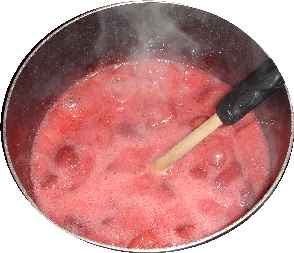
Once sugar is dissolved, cook rapidly to , or almost to, the jellying point, depending upon whether a firm or soft jam is desired. See step 9 for determining if you have a gel or "set". As mixture thickens, stir frequently to prevent sticking.
Remove from the heat.
Step 9 - Testing for "jell" (thickness)
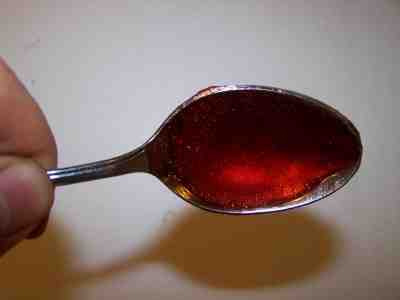 I keep a metal tablespoon sitting in a glass of ice water, then take a half spoonful of the mix and let it cool to room temperature on the spoon. If it thickens up to the consistency I like, then I know the jam is ready. If not, I mix in a little more
sugar (about 1 cup) and 2 tablespoons of lemon juice and bring it to a boil again for 1
or 2 minutes.
I keep a metal tablespoon sitting in a glass of ice water, then take a half spoonful of the mix and let it cool to room temperature on the spoon. If it thickens up to the consistency I like, then I know the jam is ready. If not, I mix in a little more
sugar (about 1 cup) and 2 tablespoons of lemon juice and bring it to a boil again for 1
or 2 minutes.
Notes about "set" (thickening or jell): It takes 3 ingredients for jams and jellies to set: pectin, sugar and acidity. The amount of pectin that is naturally occurring in the fruit varies from one type of fruit to another and by ripeness (counter intuitively, unripe contains more pectin). See this page for more about pectin in fruit. It takes the right balance, and sufficient amounts of each of pectin, sugar and acidity to result in a firm jam or jelly. Lastly, it takes a brief period (1 minute) of a hard boil, to provide enough heat to bring the three together. Generally speaking, if your jam doesn't firm up, you were short in pectin, sugar or acidity or didn't get a hard boil. That's ok - you can "remake' the jam; see this page!
Step 10 - Skim any excessive foam
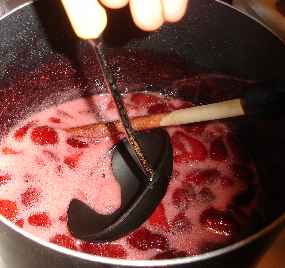 Foam...
What is it? Just jam with a lot of air from the boiling.
Foam...
What is it? Just jam with a lot of air from the boiling.  But it
tastes more like, well, foam, that jam, so most people remove it. It is
harmless,
though. Some people add 1 teaspoon of butter or margarine to the mix in
step 6 to reduce foaming, but food experts debate whether that may contribute to
earlier spoilage, so I usually omit it and skim.
But it
tastes more like, well, foam, that jam, so most people remove it. It is
harmless,
though. Some people add 1 teaspoon of butter or margarine to the mix in
step 6 to reduce foaming, but food experts debate whether that may contribute to
earlier spoilage, so I usually omit it and skim.
But save the skimmed foam! You can recover jam from it to use fresh! See this page for directions!
Step 11 - Optional: Let stand for 5 minutes and stir completely.
Why? Otherwise, the fruit will often float to the top of the jar. This isn't a particular problem; you can always stir the jars later when you open them; but some people get fussy about everything being "just so", so I've included this step! Skipping this step won't affect the quality of the jam at all. I usually don't bother.
You will also notice that the less sugar you use, the more the fruit will float (chemists will tell you it is due to the decreased density of the solution!)
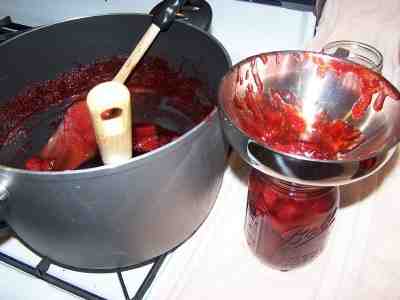 Step 12 - Fill the jars and put the lid and rings on
Step 12 - Fill the jars and put the lid and rings on
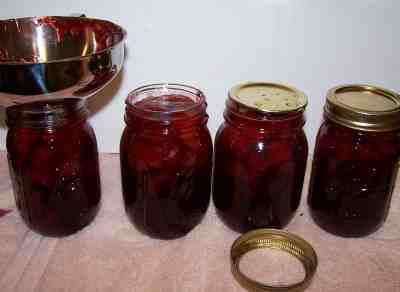 Fill them to within 1/4-inch of the top, wipe any spilled jam off the top, seat the lid and tighten the ring around them. Then put the filled jars into the canner!
Fill them to within 1/4-inch of the top, wipe any spilled jam off the top, seat the lid and tighten the ring around them. Then put the filled jars into the canner!
This is where the jar tongs come in really handy!

Step 13 - Process the jars in the boiling water bath
Keep the jars covered with at least 2 inches of water. Keep the water boiling. In general, boil them for 10 minutes, which is what SureJell (the makers of the pectin) recommend. I say "in general" because you have to
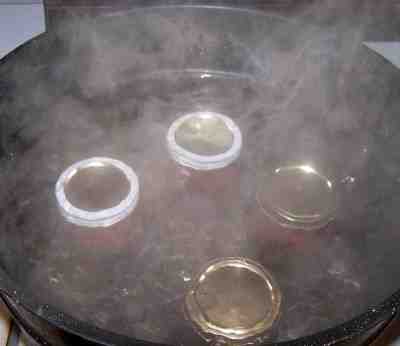 process (boil) them longer at higher altitudes than sea level, or if you use larger jars, or if you did not sanitize the jars and lids right before using them. The directions inside every box of pectin will tell you exactly. The directions on the pectin tend to be pretty conservative. Clemson University says you only need to process them for 5 minutes. I usually hedge my bets and start pulling them out after 5 minutes, and the last jars were probably in for 10. I rarely have a jar spoil, so it must work. But you don't want to process them too long, or the jam will turn dark and get runny. See the chart below for altitude adjustment to processing times, if you are not in the sea level to 1,000ft above sea level range.
process (boil) them longer at higher altitudes than sea level, or if you use larger jars, or if you did not sanitize the jars and lids right before using them. The directions inside every box of pectin will tell you exactly. The directions on the pectin tend to be pretty conservative. Clemson University says you only need to process them for 5 minutes. I usually hedge my bets and start pulling them out after 5 minutes, and the last jars were probably in for 10. I rarely have a jar spoil, so it must work. But you don't want to process them too long, or the jam will turn dark and get runny. See the chart below for altitude adjustment to processing times, if you are not in the sea level to 1,000ft above sea level range.
Note: Some people don't even boil the jars; they just ladle it hot into hot jars, put the lids and rings on and invert them, but putting the jars in the boiling water bath REALLY helps to reduce spoilage! To me, it makes little sense to put all the working into making the jam and then not to process the jars to be sure they don't spoil!
|
Recommended process time for jams in a boiling water canner. | ||||
| Process Time at Altitudes of | ||||
| Style of Pack | Jar Size | 0 - 1,000 ft | 1,001 - 6,000 ft | Above 6,000 ft |
| Hot | Half-pints or Pints |
5 min | 10 | 15 |
Step 14 - Remove and cool the jars - Done!
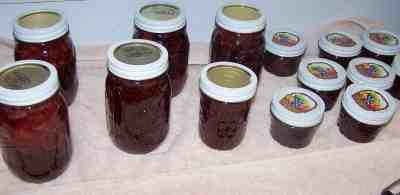 Lift the jars out of the water with your jar lifter tongs and let them cool without touching or bumping them in a draft-free place (usually takes overnight) You can then remove the rings if you like, but if you leave them on, at least loosen them quite a bit, so they don't rust in place due to trapped moisture. Once the jars are cool, you can check that they are sealed verifying that the lid has been sucked down. Just press in the center, gently, with your finger. If it pops up and down (often making a popping sound), it is not sealed. If you put the jar in the refrigerator right away, you can still use it. Some people replace the lid and reprocess the jar, then that's a bit iffy. If you heat the contents back up, re-jar them (with a new lid) and the full time in the canner, it's usually ok.
Lift the jars out of the water with your jar lifter tongs and let them cool without touching or bumping them in a draft-free place (usually takes overnight) You can then remove the rings if you like, but if you leave them on, at least loosen them quite a bit, so they don't rust in place due to trapped moisture. Once the jars are cool, you can check that they are sealed verifying that the lid has been sucked down. Just press in the center, gently, with your finger. If it pops up and down (often making a popping sound), it is not sealed. If you put the jar in the refrigerator right away, you can still use it. Some people replace the lid and reprocess the jar, then that's a bit iffy. If you heat the contents back up, re-jar them (with a new lid) and the full time in the canner, it's usually ok.
Once cooled, they're ready to store. I find they last up to 12 months. But after about 6 to 8 months, they get darker in color and start to get runny. They still are safe to eat, but the flavor and texture aren't as good. So eat them in the first 6 months after you prepare them! Another trick is to keep the uncooked berries or other fruit in the freezer and make and can the jam as needed, so it's always fresh.
Summary - Cost of Making Homemade Strawberry Jam - makes 8 jars, 8 oz each** |
||||
| Item | Quantity | Cost in 2025 | Source | Subtotal |
| fresh whole berries (strawberries) | 12 cups | $9.00/gallon | Pick your own | $13.50 |
| Canning jars (8 oz size), includes lids and rings | 8 jars | $11/dozen 8 oz jars or $0.92/jar Lids alone are about $ per dozen |
Grocery stores, like Public, Kroger, Safeway and sometimes, Big Lots, local hardware stores and big box stores | $5.00 |
| Sweetener - see step 4 | 6 cups | $2.50 | Grocery stores, like Public, Kroger, Safeway and sometimes, Big Lots, local hardware stores and big box stores | $2.50 |
| Total | $21.00 total or about $2.63 per jar (if you already have the jars, and just need new lids for a total of: $2.10 per jar |
|||
| * - This assumes you already have the pots, pans, ladles,, and reusable equipment. Note that you can reuse the jars! Many products are sold in jars that will take the lids and rings for canning. Some authorities do not recommend these, saying they are more prone to break, and while I have found that is true of mayonnaise jars, I have found the Classico spaghetti jars to be pretty sturdy. |
||||
Can't find the equipment? We ship to all 50 states!
Use our Feedback form!
FAQs - Answers to Common Questions
-
As my jars are cooling after i take them out of the canner, they sometimes make a popping or hissing noise. Is this normal and safe?
Yes, the lids are designed to flex and that's actually a key selling point. You can tell if a jar hasn't sealed properly (after it has cooled completely) if the lid flexes and makes a popping sound when you press the center of the lid with your finger. The popping sounds while it is cooling is the lid being sucked down by the vacuum that is forming inside the jar - which a normal part of the sealing process. Hissing sounds are usually just escaping steam or hot water evaporating on hot surfaces, also normal! -
Why should cooked jelly be made in small batches?
If a larger quantity of juice is used, it will be necessary to boil it longer thus causing loss of flavor, darkening of jelly, and toughening of jelly. It really doesn't work. Trust me; I've tried many times! -
Can I use frozen berries instead of fresh?
Yep! Raspberries can be particularly hard to find fresh and are expensive! Frozen berries work just fine, and measure the same. Just be sure to get the loose, frozen whole fruit; not those that have been mushed up or frozen in a sugar syrup! -
When I used store-bought strawberries, and didn't crush them much, I got
separation of the fruit from the liquid, and floating fruit in the jars?
What happened?
The problem is the store bough are much less solid; more airy - partially due to the varieties grown for shipping, partly due to being picked more unripe, and partly due to drying out a bit during shipping. So they are less dense than the sugar solution surrounding them. Add to this that your didn't crush them as much.. and you get floating! They should taste ok; just stir them up when you open them.
So, if you must use store bought, crush them more and simmer them a few minutes longer (before adding the sugar) and that should at least reduce the floating! -
Should jelly be boiled slowly or rapidly?
It should be boiled rapidly since long, slow boiling destroys the pectin in the fruit juice. -
What do I do if there's mold on my jam, jelly or preserves?
Discard jams and jellies with mold on them. The mold could be producing a mycotoxin (poisonous substance that can make you sick). USDA and microbiologists recommend against scooping out the mold and using the remaining jam or jelly. See this page from the US Food Safety and Inspection Service for more information. (and this page for a pdf version) -
Why did my jellied fruit product ferment, and what do I do?
Jellied fruit products may ferment because of yeast growth. This can occur if the product is improperly processed and sealed, or if the sugar content is low. Fermented fruit products have a disagreeable taste. Discard them. -
What happens if my jam or jelly doesn't gel?
Remaking cooked runny jam or jelly instructions can be found on this page - Could you tell me why my JAM is thicker then the store bought?
The natural pectin content of fresh fruit varies, so it is possible the the variety of fruit that you used has more natural pectin, making it thicker. But there's an easy answer - just add less pectin next time. You will have to experiment to find how much pectin makes the consistency you like. Most people seem to like their jam thick, so you may to need to only use 3/4 of a pack of pectin per batch. - Must I use a water bath method to make jam? Can I use my pressure
canner or is it not really necessary?
Yes, you should use a water bath method; it cuts the spoilage rate down to almost zero. There are people who don't, by just inverting the jars, but unless your are absolutely scrupulously clean, you will get spoilage, and there is still a risk of food poisoning, albeit it smaller than with other canned products. Jams only need 5 minutes in the water bath anyway, thanks to the very high sugar content combined with the acidity.
Either water bath or pressure method works. For making strawberry jam, the water bath is easier and much faster. You needn't buy a water bath canner, if you already have a Pressure Canner, since you can use your pressure canner as a water bath canner, by simply not sealing it (allowing the vents to remain open, not putting the weight on it). - What is the best way to de-seed berries for jam? I heard a few different
ways. A food mill, a ricer, and cheese cloth.
For large seeds (blackberries, apples, and larger) I find a Foley Food Mill works best - it's certainly faster and easier than the other methods. Raspberry and smaller seeds are a real pain. They get stuck in (and clog) or pass through a food mill. The Villaware mill has a smaller screen that works great for them! See this page for more information about both strainers. Cheesecloth and jelly strainers are messy, take forever and you lose most of the pulp. For these, I find a metal sieve or colander (with small enough holes) and a spatula to help mush them and push the pulp through, is best. Also, heating the mushed up berries almost to boiling really helps to separate the seeds and pulp. - Do you have a recipe for strawberry-rhubarb jam using honey for
sweetener and using pectin as a thickener?
I haven't tried it, but it ought to be possible, as the primary sugars in honey are fructose and glucose. With a no-sugar pectin, it should work well, using the usual honey-to-sugar substitution ratios that you use elsewhere. I'd estimate, that with a no-sugar pectin, you could use 2 cups of honey per batch (of 6 cups of mashed fruit) and get a pretty good result. If anyone makes jam with honey and has any tips, write me, and I'll share them here. - Click here to see our complete list of frequently asked questions on this page!
Picking Tips
[General picking tips and a guide to each fruit and vegetable] [How
much do I need to pick?
(Yields - how much raw makes how much cooked or frozen)] [Selecting
the right varieties to pick] [All
about apple varieties - which to pick and why!] [Picking tips for Vegetables]
[ Strawberry picking tips]
[ Blueberries picking tips]
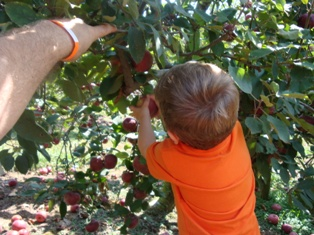
Illustrated Canning, Freezing, Jam Instructions and Recipes
[ Easy Home Canning Directions] [FAQs - Answers to common questions and problems] [Recommended books about home canning, jam making, drying and preserving!] [Free canning publications to download and print]
Looking for canning equipment and supplies?
Water bath canner with a jar rack
Pressure canners for gas, electric and induction stoves: Presto 23Qt or T-fal 22Qt
Canning scoop (this one is PERFECT)
Ball Blue book (most recent version)
Jars: 8oz canning jars for jams
Find Other types of farms:
Farm markets and roadside stands
Road trips and camping resources
Local Honey, apiaries, beekeepers
Consumer fraud and scams information
Home canning supplies at the best prices on the internet!
Maple Syrup Farms, sugarworks, maple syrup festivals
Environmental information and resources
Farms For Your Event for birthday parties, weddings, receptions, business meetings, retreats, etc.
Festivals - local fruit and vegetable festivals
Get the
most recent version of
the Ball Blue Book
With this Presto 23 quart pressure canner and pressure cooker, you can "can" everything, fruits, vegetables, jams, jellies, salsa, applesauce, pickles, even meats, soups, stews. Model 01781

You can make jams, jellies, can fruit, applesauce, salsa and pickles with water bath canners, like this Granite Ware 12-Piece Canner Kit, Jar Rack, Blancher, Colander and 5 piece Canning Tool Set

